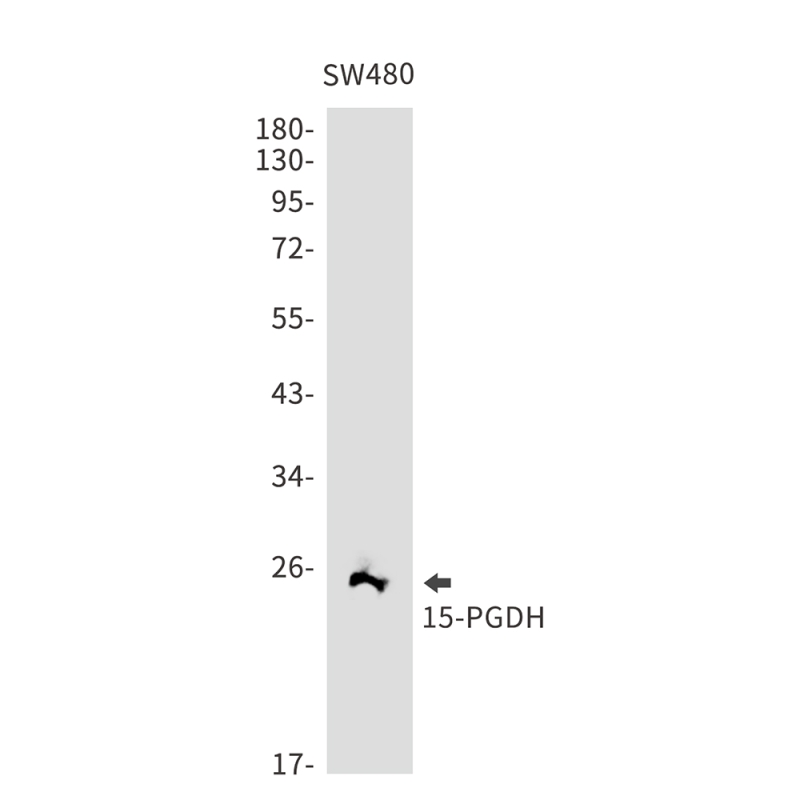
| WB | 咨询技术 | Human,Mouse,Rat |
| IF | 咨询技术 | Human,Mouse,Rat |
| IHC | 1/50-1/100 | Human,Mouse,Rat |
| ICC | 1/50-1/200 | Human,Mouse,Rat |
| FCM | 咨询技术 | Human,Mouse,Rat |
| Elisa | 咨询技术 | Human,Mouse,Rat |
| Aliases | 15-PGDH; Hpgd; PGDH; PGDH1; PHOAR1; SDR36C1 |
| Entrez GeneID | 3248 |
| WB Predicted band size | Calculated MW: 29 kDa; Observed MW: 25 kDa |
| Host/Isotype | Rabbit IgG |
| Antibody Type | Primary antibody |
| Storage | Store at 4°C short term. Aliquot and store at -20°C long term. Avoid freeze/thaw cycles. |
| Species Reactivity | Human |
| Immunogen | Recombinant protein of human 15-PGDH |
| Formulation | Purified antibody in TBS with 0.05% sodium azide,0.05%BSA and 50% glycerol. |
+ +
以下是3-4条关于15-PGDH抗体的参考文献及其摘要内容的简要概括:
---
1. **文献名称**:*15-Hydroxyprostaglandin Dehydrogenase as a Marker of Colon Cancer Risk*
**作者**:Yan Yan, Vadim Backman, Sanford Markowitz 等
**摘要**:该研究开发了针对15-PGDH的特异性抗体,用于评估结肠癌组织中15-PGDH的表达水平。通过免疫组化分析发现,15-PGDH在癌旁正常组织中高表达,而在肿瘤组织中显著降低,提示其作为肿瘤抑制因子的潜在作用。
2. **文献名称**:*15-PGDH Inhibition Enhances Tissue Regeneration via Modulation of Prostaglandin Signaling*
**作者**:John L. Cleveland, Hsin-Yi Henry Ho
**摘要**:研究利用15-PGDH抗体检测小鼠模型中该酶的表达动态,发现抑制15-PGDH活性可提高前列腺素水平,促进肝和骨髓再生。抗体在Western blot和免疫荧光中验证了靶标特异性。
3. **文献名称**:*15-PGDH as a Novel Therapeutic Target in Fibrotic Disorders*
**作者**:Daniel J. Weiss, Matthew L. Edin 等
**摘要**:通过抗体验证,研究揭示了肺纤维化患者组织中15-PGDH表达上调与其介导的前列腺素降解相关。抗体被用于阻断酶活性,证明其可能成为抗纤维化治疗的靶点。
4. **文献名称**:*Development of a Monoclonal Antibody Against Human 15-PGDH for Cancer Biomarker Studies*
**作者**:Tong Shi, Raymond N. DuBois
**摘要**:该文献报道了一种高特异性小鼠抗人15-PGDH单克隆抗体的开发,并验证其在ELISA和免疫组化中的应用。研究发现,15-PGDH低表达与多种癌症的预后不良相关。
---
注:上述文献信息为示例性概括,具体内容需以实际发表的研究为准。建议通过PubMed或Google Scholar以“15-PGDH antibody”为关键词检索最新文献。
15-Hydroxyprostaglandin dehydrogenase (15-PGDH) is a NAD+-dependent enzyme that catalyzes the oxidation of prostaglandins, particularly prostaglandin E2 (PGE2), into biologically inactive metabolites. This enzyme plays a critical role in regulating prostaglandin homeostasis, influencing processes such as inflammation, tissue repair, and cellular proliferation. Dysregulation of 15-PGDH has been implicated in various pathological conditions, including cancer, fibrosis, and inflammatory diseases. For instance, reduced 15-PGDH expression is linked to elevated PGE2 levels, promoting tumor growth and metastasis in colorectal and other cancers. Conversely, its upregulation may suppress tissue regeneration or exacerbate fibrosis.
The 15-PGDH antibody is a key tool for detecting and quantifying this enzyme in research. It enables the study of 15-PGDH expression patterns in tissues, cell lines, or disease models through techniques like Western blotting, immunohistochemistry, and immunofluorescence. Researchers use this antibody to explore 15-PGDH's regulatory mechanisms, interactions with signaling pathways (e.g., Wnt/β-catenin), and potential therapeutic targeting. For example, enhancing 15-PGDH activity or expression is being investigated as a strategy to counteract PGE2-driven pathologies. The antibody's specificity and reliability are critical for validating experimental findings, particularly in studies aiming to modulate prostaglandin metabolism for disease treatment. Its applications span cancer biology, immunology, and regenerative medicine, underscoring its importance in both basic and translational research.
×